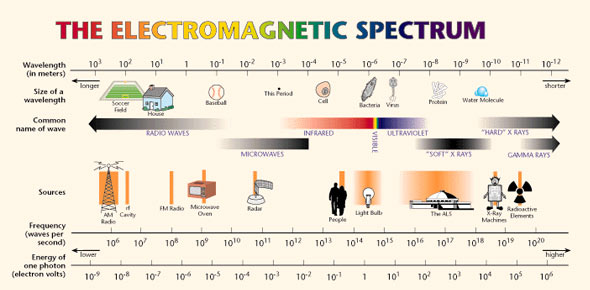Electromagnetic Spectrum Quiz Questions

A quiz over the NASA video "Video Tour Of The Electromagnetic Spectrum - 01 - Introduction"
- 1.
EMS stands for?
- A.
EletricoMovement Spectrum
- B.
ElectroMagnetic Spectrum
- C.
ElectroMagificent Spectrum
- D.
ElementaryMagetic Spectrum
Correct Answer
B. ElectroMagnetic SpectrumExplanation
EMS stands for ElectroMagnetic Spectrum. The electromagnetic spectrum refers to the range of all possible frequencies of electromagnetic radiation. This includes various types of waves such as radio waves, microwaves, infrared, visible light, ultraviolet, X-rays, and gamma rays. The electromagnetic spectrum plays a crucial role in various scientific fields, including physics, astronomy, and telecommunications.Rate this question:
-
- 2.
EM Waves travel at the constant speed of?
- A.
Light
- B.
Sound
- C.
Energy
- D.
Unknown
Correct Answer
A. LightExplanation
EM waves, or electromagnetic waves, travel at the constant speed of light. This is a fundamental principle in physics, known as the speed of light in a vacuum, which is approximately 299,792,458 meters per second. Electromagnetic waves include various forms of energy transmission, such as radio waves, microwaves, infrared, visible light, ultraviolet, X-rays, and gamma rays. Regardless of the specific type of electromagnetic wave, they all propagate through space at the same speed, which is the speed of light.Rate this question:
-
- 3.
The distance between crests is know as?
- A.
Crest Distance
- B.
Unknown Distance
- C.
Wavelength
- D.
Variable Distance
Correct Answer
C. WavelengthExplanation
The correct answer is "Wavelength". Wavelength refers to the distance between two consecutive crests or troughs in a wave. It is a fundamental property of waves and is commonly used to describe the size or length of a wave.Rate this question:
-
- 4.
Wavelengths are measured in?
- A.
Meters & Nanometers
- B.
Feet & Inches
- C.
Inches & Centimeters
- D.
Inches to CM Cal
Correct Answer
A. Meters & NanometersExplanation
Wavelengths are measured in meters and nanometers. Meters are used to measure longer wavelengths, such as those in the visible light spectrum, while nanometers are used to measure shorter wavelengths, such as those in the ultraviolet and infrared spectrums. This measurement system allows scientists to accurately quantify and compare the lengths of different wavelengths in various scientific fields, including physics, chemistry, and optics.Rate this question:
-
- 5.
The amount of crests that pass a given point within one second is discribed as the?
- A.
Pass Point
- B.
Ultraviolet Pass Point
- C.
Crest Point Through
- D.
Frequency
Correct Answer
D. FrequencyExplanation
The correct answer is "Frequency." Frequency refers to the number of crests that pass a given point within one second. It is a measure of how often a wave oscillates or repeats itself. In this context, it is used to describe the rate at which the crests of a wave pass a specific point.Rate this question:
-
- 6.
Radio waves have the lowest?
- A.
Facebook accounts
- B.
Wave Turn
- C.
Frequency
- D.
Point of Turn
Correct Answer
C. FrequencyExplanation
Radio waves have the lowest frequency among the given options. Frequency refers to the number of complete cycles of a wave that occur in a second. Radio waves have a lower frequency compared to other types of waves such as visible light or microwaves.Rate this question:
-
- 7.
Microwaves carry?
- A.
Text messages
- B.
Atoms in food
- C.
Extra Waves in microwaves
- D.
Induction of waves in EO waves
Correct Answer
A. Text messages -
- 8.
Color is seen because EM Waves interact with?
- A.
Other Waves in waves to make waves
- B.
Wide Bands of waves in water waves
- C.
Radar waves within waves to power waves
- D.
Molecules
Correct Answer
D. MoleculesExplanation
Color is seen because electromagnetic waves interact with molecules. When light waves, which are a type of electromagnetic wave, interact with molecules, they can be absorbed, transmitted, or reflected. The specific interaction between the light waves and the molecules determines the color that we perceive. Different molecules have different energy levels, and when light waves interact with these molecules, they can cause the electrons in the molecules to move to higher energy levels. When the electrons return to their original energy levels, they release energy in the form of light, and this emitted light is what we perceive as color.Rate this question:
-
- 9.
The visible light spectrum between 492NM and 577NM is interpreted as?
- A.
Green
- B.
Red
- C.
Blue mixed
- D.
NIR mixed
Correct Answer
A. GreenExplanation
The visible light spectrum between 492NM and 577NM is interpreted as green. This is because green light falls within this wavelength range. The human eye is most sensitive to green light, and it is perceived as the color associated with this wavelength range.Rate this question:
-
- 10.
EM radiation is emmitted, reflected and absorbed differently. A graph showing this interaction across the EM Spectrum is known as?
- A.
Signed of the Sign
- B.
Digital Wave
- C.
Spectral Signature
- D.
Wave Signature
Correct Answer
C. Spectral SignatureExplanation
The correct answer is "Spectral Signature". EM radiation interacts with different materials in different ways, such as being emitted, reflected, or absorbed. A graph that illustrates this interaction across the EM Spectrum is known as a spectral signature.Rate this question:
-
- 11.
How long is this video?
- A.
4:30
- B.
5:10
- C.
5:03
- D.
3:43
Correct Answer
C. 5:03Explanation
The correct answer is 5:03 because it is the only option that matches the given time format. The other options do not have the correct combination of minutes and seconds.Rate this question:
-
Quiz Review Timeline +
Our quizzes are rigorously reviewed, monitored and continuously updated by our expert board to maintain accuracy, relevance, and timeliness.
-
Current Version
-
Mar 22, 2023Quiz Edited by
ProProfs Editorial Team -
Mar 26, 2013Quiz Created by
MASINT
 Back to top
Back to top


